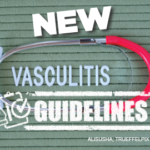Some of the studies showed that a lot of the patients who had intervention or surgery when the vessel was actively inflamed did not do as well.9 So that’s also a consideration.
Another consideration is that, in general for renal artery stenosis, regardless of the type of artery stenosis, treatment with anti-hypertensives is preferred initially.
Again, there are some caveats. If you have a patient with critical organ or extremity ischemia, stroke-type symptoms or myocardial ischemia, you may need to intervene immediately.
The guideline recommends either a surgical procedure or a catheter-based procedure in those cases. Ideally, however, such a patient would be treated with high-dose glucocorticoids prior to the procedure to try to control the inflammation.
We also thought it was important to bring the vascular surgeon into discussions to decide the appropriate therapeutic approach.
I think it’s important to keep in mind that all of these are guidelines; they’re supposed to help the clinician make decisions, but they’re not going to replace clinical judgment. Often, the guidelines may not apply to a specific clinical scenario. The idea is to give some tools to clinicians that they can use along with their best possible judgment.
It was definitely a privilege to participate with such a great group of rheumatologists on creating the guideline for Takayasu arteritis, and a wonderful experience personally for me, as somebody who has been interested in vasculitis for many years.
Michael Putman, MD (@EBRheum), is an assistant professor at the Medical College of Wisconsin, Wauwatosa, where he is the associate fellowship program director and the medical director of the vasculitis program.
References
- Chung SA, Langford CA, Maz M, et al. 2021 American College of Rheumatology/Vasculitis Foundation Guideline for the Management of Antineutrophil Cytoplasmic Antibody–Associated Vasculitis. Arthritis Rheumatol. 2021 Aug; 73(8):1366–1383; and Arthritis Care Res (Hoboken). 2021 Aug; 73(8):1088–1105.
- Maz M, Chung SA, Abril A, et al. 2021 American College of Rheumatology/Vasculitis Foundation Guideline for the Management of Giant Cell Arteritis and Takayasu Arteritis. Arthritis Rheumatol. 2021 Aug;73(8):1349–1365; and Arthritis Care Res (Hoboken). 2021 Aug; 73(8):1071–1087.
- Chung SA, Gorelik M, Langford CA, et al. 2021 American College of Rheumatology/Vasculitis Foundation Guideline for the Management of Polyarteritis Nodosa. Arthritis Rheumatol. 2021 Aug; 73(8):1384–1393; and Arthritis Care Res (Hoboken). 2021 Aug; 73(8):1061–1070.
- Jennette JC. Overview of the 2012 revised International Chapel Hill Consensus Conference nomenclature of vasculitides. Clin Exp Nephrol. 2013 Oct;17(5):603–606.
- Mekinian A, Resche-Rigon M, Comarmond C, et al. Efficacy of tocilizumab in Takayasu arteritis: Multicenter retrospective study of 46 patients. J Autoimmun. 2018 Jul; 91:55–60.
- Nakaoka Y, Isobe M, Takei S, et al. Efficacy and safety of tocilizumab in patients with refractory Takayasu arteritis: Results from a randomised, double-blind, placebo-controlled, phase 3 trial in Japan (the TAKT study). Ann Rheum Dis. 2018 Mar; 77(3):348–354.
- Novikov PI, Smitienko IO, Sokolova MV, et al. Certolizumab pegol in the treatment of Takayasu arteritis. Rheumatology (Oxford). 2018 Dec 1; 57(12):2101–2105.
- Aeschlimann FA, Eng SWM, Sheikh S, et al. Childhood Takayasu arteritis: Disease course and response to therapy. Arthritis Res Ther. 2017 Nov 22; 19(1):255.
- Zheng T, Zhu S, Ou J-F, et al. Treatment with corticosteroid and/or immunosuppressive agents before surgery can effectively improve the surgical outcome in patients with Takayasu’s arteritis. J Invest Surg. 2019 Apr; 32(3):220–227.
- Gorelik M, Chung SA, Ardalan K, et al. 2021 American College of Rheumatology/Vasculitis Foundation Guideline for the Management of Kawasaki Disease. Arthritis Rheumatol. 2022 Apr; 74(4):586–596; and Arthritis Care Res (Hoboken). 2022 Apr;74(4):538–548.


